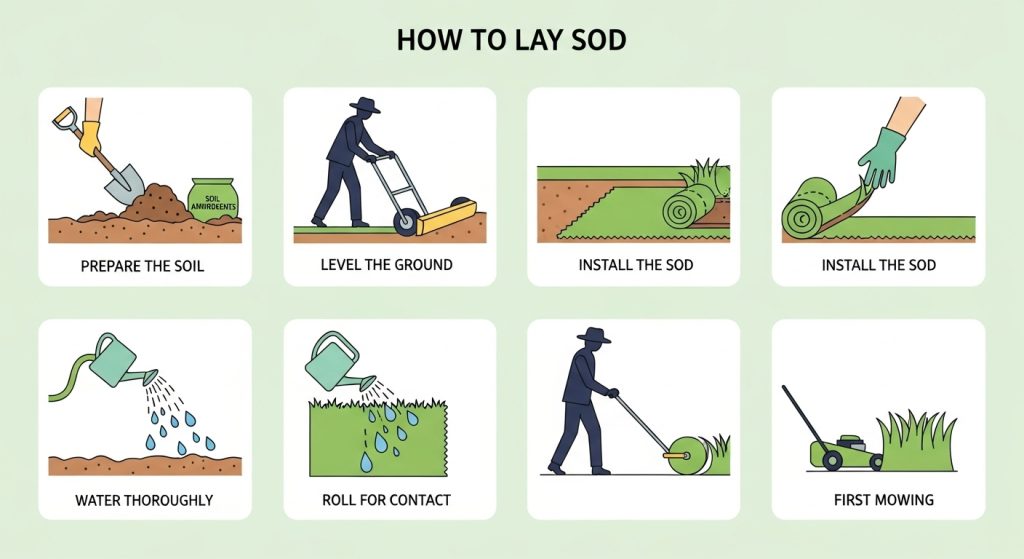How to Lay Sod: Your Ultimate Guide to a Beautiful Lawn
How to lay sod is the fastest way to achieve a lush, green lawn without waiting months for grass seed to grow. By following the right steps, you can transform bare soil into a vibrant yard in just a day. This guide will walk you through everything from preparation to maintenance for long-lasting results.

Materials and Tools Needed for Sod Installation
Before you start laying sod, you need to gather the necessary tools and materials. Here’s a detailed list to prepare you for the task at hand:
Essential Tools
- Sod Cutter: This tool helps you remove old grass and prepares the surface for new sod. It’s crucial for starting with clean soil.
- Iron Rake: Use this for leveling and grading the soil, essential to create a smooth, even base for the sod.
- Lawn Roller: A lawn roller firms sod against the soil, ensuring tight contact that helps the roots establish quickly.
- Edger/Shovel: This tool helps trim sod for precise fitting along edges and curves, giving your lawn a clean look.
- Soil Probe: A soil probe measures moisture levels in the ground, ensuring you add the right amount of water before and after installation.
Required Materials
- Quality Sod: Choose sod that’s compatible with your local climate and sunlight conditions. Make sure it’s pre-grown and healthy.
- Topsoil: Apply nutrient-rich topsoil to create a vigorous root structure for healthy grass growth.
- Compost or Starter Fertilizer: Incorporate compost or a starter fertilizer to improve soil health and nutrient availability.
- Lime: Depending on your soil test results, you might need lime to raise pH levels if your soil is too acidic.
Gather your tools and materials before commencing the installation process to ensure a smooth experience.
Preparing the Soil Before Laying Sod
Soil preparation is a vital step in the sod installation process. Properly prepared soil promotes strong root establishment and helps prevent issues down the line.
Why Soil Preparation Matters
- Remove Old Plants and Weeds: Clear the area to eliminate competition for nutrients, water, and sunlight.
- Create a Smooth Surface: This facilitates uniform growth and helps the sod roots anchor securely.
Step-by-Step Soil Preparation
- Clear the Area:
- Remove all grass, weeds, and debris. Don’t forget to mark sprinkler heads to avoid damage while clearing out the area.
- Remove all grass, weeds, and debris. Don’t forget to mark sprinkler heads to avoid damage while clearing out the area.
- Grade the Soil:
- Level the soil and create a slight slope away from structures for proper drainage. This prevents water pooling, which can damage sod roots.
- Level the soil and create a slight slope away from structures for proper drainage. This prevents water pooling, which can damage sod roots.
- Conduct a Soil Test:
- Test your soil for pH and nutrient levels. Knowing what your soil needs is crucial for creating optimal conditions.
- Test your soil for pH and nutrient levels. Knowing what your soil needs is crucial for creating optimal conditions.
- Amend the Soil:
- Based on your soil test results, you might need to add lime to reduce acidity. Incorporate compost or starter fertilizer to enrich the soil.
- Based on your soil test results, you might need to add lime to reduce acidity. Incorporate compost or starter fertilizer to enrich the soil.
Taking the time to prepare your soil properly can make all the difference in your sod installation project.
Step-by-Step Guide on How to Install Sod
Now that your soil is primed and ready, let’s move on to the installation phase. Here’s a clear, step-by-step process demonstrating how to install sod efficiently.
Understanding Sod Installation
Sod installation involves laying pre-grown grass rolls onto the prepared bed to establish your lawn immediately.
Step-by-Step Installation Process
- Start at a Straight Edge:
- Begin laying sod along the longest straight edge, which could be a driveway or fence. This simplifies alignment.
- Begin laying sod along the longest straight edge, which could be a driveway or fence. This simplifies alignment.
- Stagger the Joints:
- Lay sod in a brick pattern by staggering joints in alternating rows. Cut half-length pieces at row starts; this reduces erosion and enhances stability.
- Lay sod in a brick pattern by staggering joints in alternating rows. Cut half-length pieces at row starts; this reduces erosion and enhances stability.
- Tighten Edges:
- Press sod pieces tightly against each other without overlapping to avoid gaps or wrinkles. Gaps could invite weed growth and wrinkles may dry out the grass.
- Press sod pieces tightly against each other without overlapping to avoid gaps or wrinkles. Gaps could invite weed growth and wrinkles may dry out the grass.
- Use a Lawn Roller:
- After installing, roll over the sod to ensure contact with the soil. This aids in rooting and establishes a solid foundation.
- After installing, roll over the sod to ensure contact with the soil. This aids in rooting and establishes a solid foundation.
- Trim Sod to Fit:
- Carefully cut edges and curves using an edger or shovel, ensuring a neat fit around any obstacles.
- Carefully cut edges and curves using an edger or shovel, ensuring a neat fit around any obstacles.
- Water Immediately:
- Don’t delay; water the newly installed sod immediately to prevent drying out, even during installation.
- Don’t delay; water the newly installed sod immediately to prevent drying out, even during installation.
This methodical approach ensures a smooth and successful sod installation, paving the way for a beautiful lawn.
Laying Sod Tips for a Successful Installation
A successful sod installation goes beyond just laying the grass. Here are some laying sod tips to maximize your lawn’s health and growth.
Practical Advice for Success
- Immediate Watering: Water newly laid sod right after installation. Continue to water daily for at least one week unless rainfall occurs. Progressively reduce frequency over the next three weeks.
- Minimize Foot Traffic: Keep foot traffic off the new sod for at least three weeks, allowing roots to establish without disturbance.
- Apply Starter Fertilizer: About four weeks after installation, apply starter fertilizer to promote vigorous growth. This helps roots establish and spreads across the lawn efficiently.
- Mow Wisely: First mow only when the grass reaches about 3 inches tall—around 10 days after installation. Use sharp blades to make clean cuts, and avoid trimming more than a third of grass height.
Implementing these tips will contribute significantly to your sod’s successful establishment and long-term health.
Aftercare and Maintenance of Newly Laid Sod
After the sod is installed, maintaining it is crucial for ongoing health and growth.
Key Aftercare Practices
- Adjust Watering Routine: Transition from daily watering to a weekly schedule over about three weeks. Always observe grass health and weather conditions to tailor your approach.
- Mow Regularly: Begin mowing two to three weeks after installation. This promotes lush growth and density while avoiding stressing the grass.
- Long-term Maintenance Techniques:
- Fertilize periodically based on soil tests to provide adequate nutrients.
- Monitor for pests and treat as necessary.
- Be cautious about overwatering, particularly in shaded areas where grass needs less moisture and nutrients.
Proper aftercare is vital in solidifying your investment and guarantees a long-lasting, flourishing lawn.
Common Mistakes to Avoid When Installing Sod
Recognizing and avoiding common mistakes can save you time, money, and frustration. Here are some of the most frequently made errors during sod installation:
Frequent Installation Errors
- Improper Soil Preparation: Failing to clear or level the soil can lead to poor root growth, bumps, and uneven turf surfaces.
- Insufficient Watering: Not watering immediately after laying sod can cause it to dry out, leading to patches of dead grass. Always ensure adequately soaked sod to promote establishment.
- Leaving Gaps and Wrinkles: Gaps invite weed intrusion and inhibit root contact, while wrinkles can dry out, resulting in unsightly sections of lawn.
By being aware of these pitfalls and how to avoid them, you’ll set up your new lawn for success from the beginning.
Note: When planning outdoor activities after laying sod, it’s also important to dress comfortably for the weather. Check out this guide on what to wear in 70-degree weather to stay stylish and comfortable.
Conclusion
In this comprehensive guide on how to lay sod, we covered essential steps such as thorough soil preparation, precise sod installation, proper watering, and maintenance, and pitfalls to avoid. Following this sod installation guide ensures your lawn not only looks great but thrives in the long run. Feel confident in applying these laying sod tips for a lush, healthy lawn. If you require personalized assistance, consider reaching out to lawn care professionals in your area for expert help.
By carefully following these steps, you will successfully transform your outdoor space into a verdant retreat. For more tips and resources, feel free to explore additional information available online.
Key Takeaways
- Proper soil preparation and high-quality sod are essential for a successful installation.
- Immediate watering and minimizing foot traffic can significantly affect sod establishment.
- Regular maintenance, such as mowing and fertilizing, will keep your lawn healthy and vibrant.






